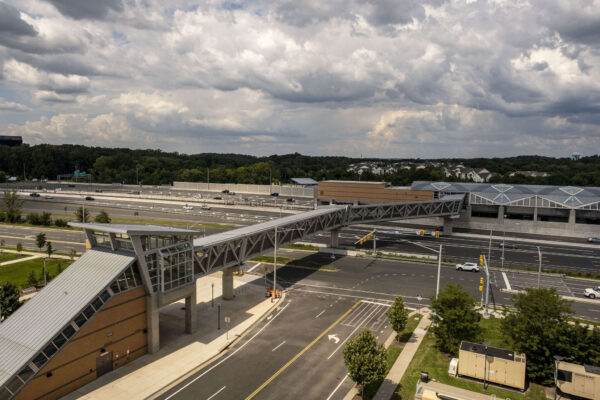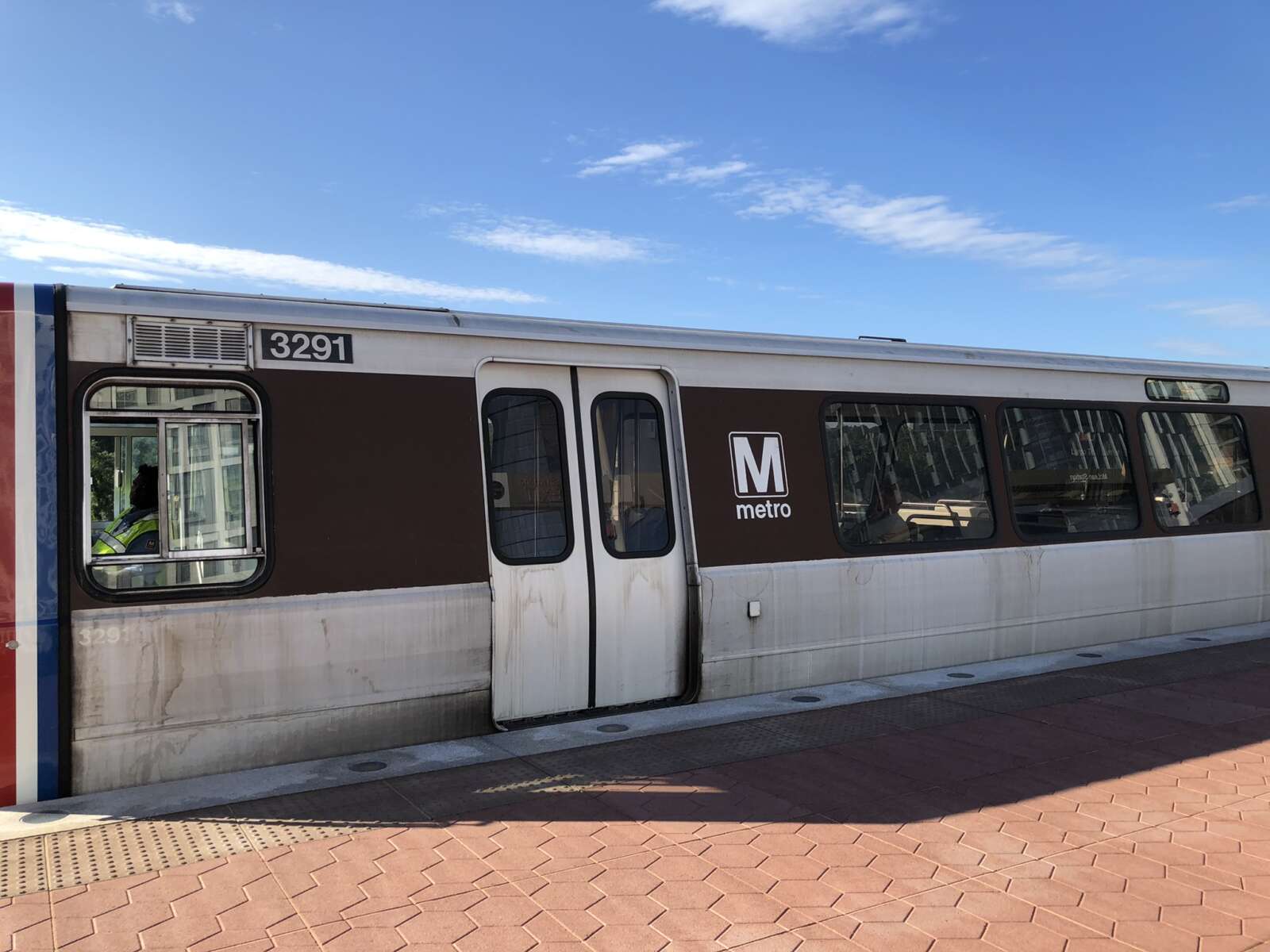
Local and state officials in Virginia say the path to dig Metro out of its looming $750 million deficit is uncertain — but action is necessary to avoid the significant service cuts, systemwide fare hikes, layoffs and station closures laid out in the transit agency’s newly proposed budget.
Leaders in Fairfax County — which already faces lean economic times — say they don’t plan to offer up additional funds unless jurisdictional and federal partners can throw some more skin into the game.
“What we have said is there’s absolutely no way that local governments can bear the responsibility of that entire bill,” Fairfax County Board of Supervisors Chairman Jeff McKay told FFXnow in an interview before the Washington Metropolitan Area Transit Authority released its official budget proposal.
WMATA has been sounding the alarm on its projected budget shortfall since June.
“What I think you’re going to see happen is there’s going to be some matching and some partnerships,” McKay said.
In a first glimpse of the proposed budget, which was released last Tuesday (Dec. 12), Metro General Manager Randy Clarke laid out what would happen if Metro can’t secure local, state and federal funds to address a problem that has been coalescing for years.
“Metro is facing an unprecedented, existential crisis that requires our region to rally together if we want to avoid the catastrophic impacts this budget would have on our region,” he said.
The system would close at 10 p.m. every day and shutter 10 low-ridership stations. Silver Line trains would turn back at Stadium-Armory, with trains running between Ashburn and that station. Similar reduced turn-backs would take place on the Red Line.
Trains would run every 15 minutes for most stations — a 17 to 67% increase in wait-times across the board on weekdays — and every 20 minutes on weekends for most stations — a 40 to 70% increase. Fares would also jump by 20%.
Among other cuts and more than 2,000 layoffs, Metro would use $193 million from its capital funds to cover operating maintenance expenses — essentially borrowing against the future.
“Such a large transfer of capital funds to operating expenses puts the system’s state of good repair, including safety and reliability, at risk, and threatens to delay, defer, decrease, or cancel several long-term projects to modernize the system,” WMATA cautioned in a press release.
But it’s unclear when and if local and state bodies will offer up enough funding. The subsidized system relies on annual subsidies from Maryland, Virginia and D.C., as well as fare revenue and federal dollars. The fiscal year 2025 budget begins July 1, 2024.
Metro needs subsidy increases of $180 million from Virginia, which has already allocated $348 million. Similar increases are sought from other jurisdictions. The upcoming General Assembly session will determine how much the state is willing to put down to assuage the bleeding after federal COVID-19 funding ends for the system. Read More
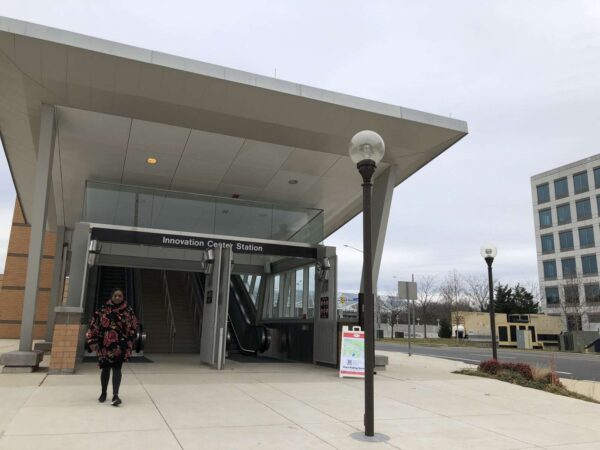
Two stops on Metro’s Silver Line have risen above all others since the rail line was extended into Loudoun County last fall.
The stations at Dulles International Airport and Ashburn remain the most popular so far, continuing a trend seen in the first month of operations for the extension, according to Metro officials.
At a Washington Metropolitan Area Transit Authority board meeting on Thursday (May 11), Metro Director of Performance Improvement Jordan Holt said that nearly a third of all Silver Line Phase II trips start or end at the Dulles stop. Additionally, a quarter of all trips start or end at Ashburn.
“Downtown D.C. is a draw,” Holt said.
She also noted that more than half of all customers traveling from Silver Line Phase II stations went to one of 12 stations. Roughly 35% went to Silver Line stations in D.C., while 14% traveled to Silver Line stations in Virginia. Three percent went to Union Station.
The extension began service on Nov. 15 after years of delays. The second phase of the Silver Line includes 11.5 miles of the rail line, including stations in Herndon, Reston Town Center, and Innovation Center.
So far, there have been more than 1.1 million trips on the new extension in its first five months of service.
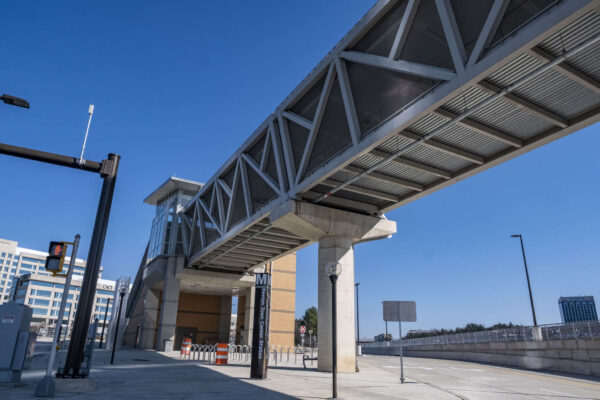
(Updated at 2:20 p.m.) Fairfax County first responders were sent to an incorrect address during a 911 call for a cardiac arrest incident at the Reston Town Center Metro station yesterday (Tuesday), leading to a delay in the response.
Based on information provided by Metro, the Fairfax County Department of Public Safety Communications dispatched emergency crews to 1901 Reston Metro Plaza — an address next to the Wiehle-Reston East Metro station, reported local public safety watcher Dave Statter.
Personnel then received an address change about 10 minutes later directing them to 12023 Sunset Hills Road, the north pavilion for the Reston Town Center station about two miles away, according to Statter.
A county spokesperson provided the following statement to FFXnow, confirming that there was a mix-up in the address:
On March 21 the Fairfax County Department of Public Safety Communications (DPSC) received a call from the Washington Metropolitans Area Transit Authority (WMATA) via the non-emergency phone line at 09:06:59 reporting a cardiac arrest at the Wiehle Metro Station. DPSC dispatched Fairfax County Fire and Rescue (FRD) to the incident at 09:08:45. The first unit arrived at the dispatched location at 09:13:10. This was identified as the incorrect location by responding personnel. Working together, FRD and DPSC redirected resources to the correct location, Reston Metro Station and arrived on the incident scene at 09:19:29.
The man later died at a hospital, according to the report.
Ian Jannetta, spokesperson for WMATA, said the organization is investigating the incident.
“Metro addresses a number of medical emergencies related to customers daily,” Janetta said. “We are looking into our response to this incident and how we can improve our efforts in the future. Our deepest sympathies are extended to our customer and their family.”
Statter says this isn’t the first time WMATA provided an incorrect address in the past.
WMATA confirmed that its control center initially gave an incorrect station address to the county fire department, noting that Metro workers were administering CPR before emergency responders arrived.
“It was rectified with Fairfax EMS during the response to the incident during which time CPR was being provided prior to their arrival,” Janetta said. “We are verifying all station addresses systemwide to ensure our control centers and jurisdictional partners have the correct information.”
(1) @fairfaxcounty confirms @WMATA gave the wrong address for the Reston Town Center #Metro Station. It delayed fire & EMS getting to a man in cardiac arrest. That man died. How did this mistake occur? #WMATA isn't saying but it fits a pattern. (more) @wmatagm pic.twitter.com/19I8QDdiI3
— Dave Statter (@STATter911) March 22, 2023

The atmosphere of the recently opened Reston Town Center Metro station will get a boost with artwork planned for this year.
Artist George Bates is working on artwork inspired by Reston’s founder Bob Simon and the statement “You can’t have a Utopia of one.”
The artwork, titled “Ethos,” is made of ceramic grit printed on safety-glass art panels.
Areas near the entrances of the stations at Ashburn and RTC will be replaced with glass art panels with images inspired by the communities around the station and poetry by local poets, according to Sherri Ly, a spokesperson for Metro.
Here’s more from Metro on the artwork:
The artwork is multifaceted and thought of as a dialogue in which everyone can participate. Bates’ design for the station can be seen as referencing artistic movements and philosophies such as Brutalism, Modernism, Wabi-Sabi, and Universal Constructivism, or as an echo of the biophilic character of Reston’s history of natural and environmental integration, growth, and togetherness. It may also be experienced as a representation of emotional delight, as the “Play” from the “Live, Work, Play” maxim of Reston’s founding vision. Ultimately, it’s about the past, present, future, enduring ideas, and histories that transcend time.
Bates has created 10 large-scale public artworks in the U.S. and several more are in progress. His work focuses on exploring the plastic nature of systems, communities, complexities, and the reality of society in relation to art.
“Both Reston Town Center and Ashburn have similar concepts,” Ly wrote in a statement to FFXnow.
Metro expects to install the artwork in the summer, she said.
The art was commissioned by the Washington Metropolitan Area Transit Authority through its Art in Transit initiative.
Four of the six new stations in phase two of the Silver Line — Herndon, Innovation Center, Washington-Dulles International Airport, and Loudoun Gateway — all have new artwork.
Several other stations also have artwork. A temporary installation called “Community in Motion” at the Tenleytown station brings a mix of color to construction barricades. It’s designed by artist Tamao Nakayama.
The cold and rain didn’t dampen enthusiasm for the opening of Metro’s long-awaited, $3 billion Silver Line Phase II.
Yesterday marked the much-anticipated public opening of the 11.4-mile extension of the rail line from Reston into Loudoun County. Along with six new stations, this marks the first time that locals can take a train to Dulles International Airport.
Over multiple ribbon-cutting ceremonies throughout the chilly, wet November day, local officials touted the debut of the line as a “game-changer” and a “new era” for western Fairfax County and the D.C. region as a whole.
“It really is the establishment of a new identity for the Dulles corridor,” Hunter Mill District Supervisor Walter Alcorn said at the new Reston Town Center station. “Now, what we’re going to see is the Dulles corridor tied together with transit in a way that was really never anticipated…We are in a new era.”
Riders, too, recognized what this could mean for the region and their daily travel.
“It’s going to change my life,” Raj Paradaar told FFXnow while riding the extension’s first passenger-filled train heading westbound. He lives in Ashburn and works near the Reston Town Center station, so he plans to ride the Metro most days.
Inside the Innovation Center station, commuters came and went, including a United Airlines flight attendant headed to work at Dulles. He lives in an apartment building across the street from the new station, along with a number of other flight attendants, FFXnow was told.
“That’s where we live,” the United Airlines flight attendant said pointing outside. “And that’s where we work…Honestly, taking a train is just much easier.”
Other riders said the extension won’t significantly affect their day-to-day habits, but they agreed it will make getting to the airport simpler.
Franconia resident Terry Rice, clutching luggage, happened to have a trip to Italy scheduled on the extension’s opening day. While planning, she realized that Dulles Airport was now only a train ride away.
“It may not change my life, but it’s going to make my life much easier,” Rice said.
Pulling into Reston Town Center station, the first stop on the new line. pic.twitter.com/83JP2LwMQh
— Matt Blitz (@WhyBlitz) November 15, 2022
During yesterday’s ceremonies, officials tried to make clear that the Silver Line extension’s impact is anticipated to go beyond simply being a link to the airport, reiterating a message that many have been saying for years.
“We have within our grasp…the ability to completely reinvent, reimagine [this corridor] as mixed-use development, as transit-oriented development, as environmentally friendly, as improving quality of life, as reducing carbon emissions, and as restoring choices for people who live in Northern Virginia,” said newly reelected Rep. Gerry Connolly (D-11) at a ceremony outside of the Innovation Center station. Read More

(Updated at 3 p.m.) It’s official: the first train on phase two of the Silver Line extension project will take off at 1:54 p.m. from the Ashburn Metro Station on Nov. 15, Metro announced today.
The train will travel the full 11.4-mile extension from Loudoun County to Downtown Largo in Maryland.
“The start of passenger service will commence following a grand opening celebration and ribbon cutting at the Washington Dulles International Airport Station to recognize this generational infrastructure investment,” Metro announced.
The opening will be preceded by a grand opening celebration that day. Only 100 customers will have a chance to receive a “Silver Ticket” to join Metro General Manager Randy Clarke and other officials for a preview ride before passenger service begins.
Here’s how to enter for the ticket:
Share your favorite memories with us on social media by tagging us on Twitter @wmata, Instagram @metroforward, and on Facebook @Metro Forward and use #YourMetroMemory. Customers can also email us at csvc@wmata.com with the subject line: Silver Ticket Metro Memory. Submissions must be sent by 5 p.m. on Thursday, November 10. Customers will be notified by noon, on Monday, November 14. Metro will select 50 customers plus a guest who will receive a “Silver Ticket” departing Wiehle-Reston East at 1:15 p.m. direct to Ashburn where the train will officially begin passenger service.
Transportation Secretary Pete Buttigieg is expected to attend that event at 11 a.m.
New: Transportation Sec. Pete Buttigieg will attend the opening of the new Silver Line extension on Nov. 15, WMATA Board Chair Paul Smedberg said at the @NoVaTransit meeting last night.
The opening event at Dulles Airport station will start at 11 a.m. https://t.co/pZYoaZ32uy
— Jordan Pascale🎙️ (@JWPascale) November 4, 2022
The first full-length westbound trip will depart from Downtown Largo at 12:51 p.m. to Wiehle-Reston East and the six new stations. Trains will run every 15 minutes from end-to-end.
Once the Silver Line opens, Metrobus 5A and the Silver Line Express Bus will be discontinued the next day.
While Dulles Airport will get the big ribbon-cutting, Fairfax County is planning to celebrate the Silver Line extension’s long-awaited opening next week in Reston as well.
County officials will gather at the office building at 1950 Opportunity Way, which overlooks the new Reston Town Center station, on Tuesday, Nov. 15 at 3:30 p.m.
“Join elected officials, business leaders and community members to celebrate the long-awaited opening of the Silver Line station at Reston Town Center,” a flyer invite to the event says.
Attendees will also be able to ride the new Reston Town Center shuttle and get information on the new Fairfax Connector bus routes that will start running that day. The new lines will run between the Reston Town Center, Herndon, and Innovation Center Metro stations.
Fatimah Waseem contributed to this report.
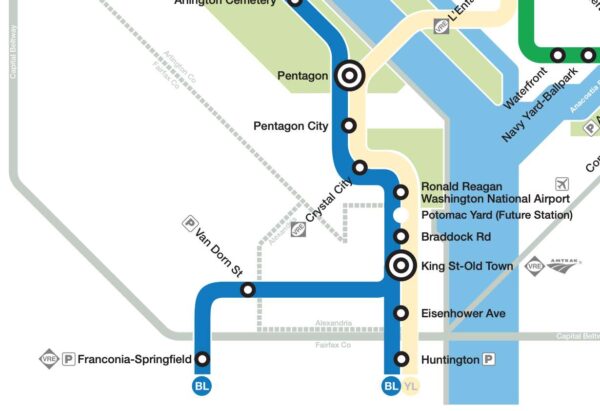
The six Metro stations south of Reagan National Airport are reopening this weekend with Blue Line service replacing the Yellow Line service.
Braddock Rd, King St-Old Town, Eisenhower Ave, Huntington, Van Dorn St, and Franconia-Springfield stations will all reopen on Sunday (Nov. 6) after being closed for nearly two months. The stations were initially scheduled to reopen two weeks ago, on Oct. 23.
The closures were needed to connect the new Potomac Yard station to the main rail system, though that station’s opening was also pushed back to next year.
When service restarts this weekend, the two Yellow Line-only stations will see some changes to their normal operations.
With rehab and construction still ongoing on the Yellow Line bridge and tunnel, all trains coming and going from Huntington and Eisenhower will run with Blue Line service and be routed through Rosslyn. Trains will run every 15 minutes along the whole line, per Metro.
This is scheduled to continue until at least May 2023, when it’s expected the rehabilitation will be completed.
Most shuttle service at those stations will also stop starting Sunday, but Metro will continue to provide limited-stop shuttles that cross the Potomac during weekday rush hours. In addition, parking will no longer be free at the Van Dorn Street, Huntington, and Franconia stations.
The end of the station closures continue a week of good news for Metro.
On Halloween, the transit service announced that the long-awaited Silver Line Phase II is finally set to start service on Nov. 15. Then, Metro said that train service will increase over the next two months with the long-sidelined 7000-series trains getting back on the tracks.
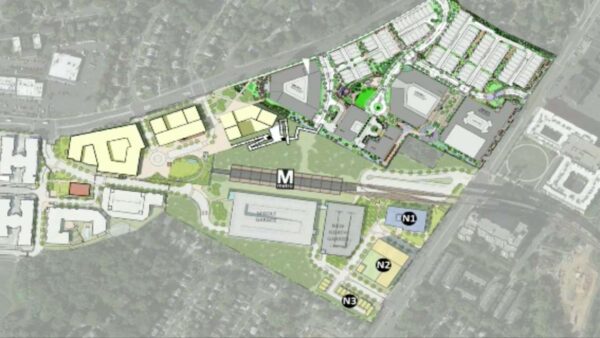
Trees, steep hills, pedestrian paths, building heights, and townhomes were the most talked-about elements during last week’s discussion about the redevelopment of the Huntington Transit Station Area.
At the Oct. 19 Planning Commission meeting, commissioners and the public weighed in with their thoughts and concerns on the proposed revamp of the Huntington Transit Station Area (TSA).
The staff’s comprehensive plan amendment calls for mixed-use development including 382,000 square feet of office, retail, and community-use space, the possibility of a hotel with conference facilities, and 1,500 residential units. 15% of those units at “minimum” should be affordable, the report notes.
A bus rapid transit station is also being called for with a “large, publicly accessible civic plaza” above the station. Plus, more urban park space and “a network of high-quality pedestrian and bicycle paths” connecting to the transit stations and other amenities are also being recommended.
To make room for the redevelopment, it’s being asked that the northern parking garage be torn down.
While a decision was delayed until Nov. 16 on if to approve the comprehensive plan, a lengthy discussion ensued at last week’s meeting. The conversation included the commissioners, county staff, the Mount Vernon Site-Specific Plan Amendment (SSPA) Task Force, Washington Metropolitan Area Transit Authority (WMATA), and the public.
The discussion focused prominently on the site’s challenging topography, the possible addition of townhomes on the northeastern side of the project, preserving a tree buffer, the potentially costly addition of one particular pedestrian path, and building heights.
There are a number of engineering challenges associated with the project mostly due to the Huntington Metro station being located on a steep hill.
“The most significant and defining feature of this site is the grade, from north to south. The highest point of the site is in the southern end on N. Kings Highway and it’s approximately 160 above sea level,” said Graham Owen from the county’s Dept. of Planning and Development. “In contrast, the lowest point of the site is on the northern portion along Huntington Ave and that’s at approximately 30 feet above sea level. So, there are about 130 feet of grade change along the site.”
This extra layer requires adaptation, both in terms of engineering and user experience, particularly when it comes to the building of roads, pedestrian pathways, and buildings.
“That is a hill like you’ve never seen…if you want to work out, run up and down North Kings Highway,” Franconia District Commissioner Dan Lagana noted with a laugh in midst of a discussion about how best to build paths for pedestrians.
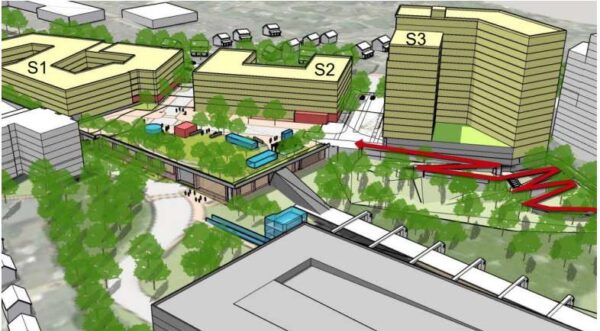
This challenge also relates to building height. If buildings on the southern end of the site are allowed to go up to the maximum allowable height of 200 feet, they could look a lot taller to those seeing the buildings from the north. This was a point of concern for several residents that spoke during the public hearing portion.
“I’d like them to really think about the height of a [200-foot] building. We can already see the parking garage over the tops of the trees,” said one resident. “If they are going to put something that’s two or three times taller than what’s already there, we will have a loss of complete privacy. I’m not opposed to development, but I don’t think that’s great development for people who have bought homes [there].”
Also, in the northeastern portion of the site, there’s currently a tract of trees that has become the subject of perhaps the most significant disagreement about the comprehensive plan.
The tract of trees near the intersection of Huntington Ave and Biscayne Drive acts as essentially a buffer between the townhomes along Biscayne Drive and the Metro station. It’s also where WMATA has proposed selling the land to a developer to build more townhomes.
Steven Segerlin, WMATA’s director of real estate and station area planning, noted that the major barriers to this project – at least from WMATA’s perspective – are financial.
“Based on initial estimates, construction costs… will be significantly greater than the revenue generated by the private developers that could possibly help pay for them,” he said.
Because of this, WMATA wants to sell the land where the trees are to developers for the building of townhomes. Both the staff report and the Mount Vernon SSPA Task Force proposed keeping the trees.
“Giving the high cost for public infrastructure needed to address the area’s lack of connectivity, the Huntington Metro site needs to generate as much revenue as possible to help pay for them,” said Segerlin. “The loss of the townhome development potential significantly reduces that revenue potential and will increase the gap funding request to the county, state, and federal government.”
He further noted that not only does Metro not have the funds to make up this gap, but the agency’s “policy does not allow it.”
Ellen Young of the Mount Vernon SSPA Task Force expressed surprise at this WMATA request. She noted, along with several residents and staff, how the trees are an important buffer between the homes already there and the Metro station. In addition, they are needed to help ease stormwater concerns in a part of the county that does have flooding.
“We had all agreed to the fact that the trees were going to stay there. And that agreement included WMATA,” said Young. “So, I think we were all caught a little off guard tonight.”
Also, a subject of concern from WMATA was a certain pedestrian path that would lead from the condo community Huntington Club to the southern portion of the development. The agency asked it not to be a “requirement” for the entire plan to move forward.
Between dealing with the steep hill and the need to potentially also build also through a grove of trees, the expense could end up being great noted Segerlin. Both staff and the task force appeared to agree that the one path was likely to be more difficult to develop and seemed open to moving forward without it.
Overall, there was considerable agreement on the goals of the comprehensive plan, which is to redevelop the area near the Huntington Metro station to make it denser, more accessible, safer, more inviting, and full of amenities available to the entire Huntington community.
“Development in this area will enhance the character of the community, increase patronage for existing local businesses and lead to reinvestment in the surrounding neighborhoods,” reads the staff report. “The area will become a place where county residents can live, work and shop without excessive dependence upon the automobile, thus realizing some of the county’s key policy objectives.”
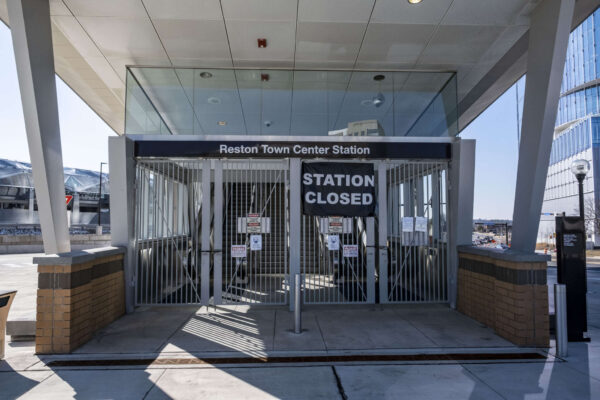
As the county officially approves paying an additional $40 million to finish the Silver Line Phase II, fare evasion continues to irk supervisors.
At yesterday’s Board of Supervisors meeting, the county followed through on the transportation committee’s recommendation last month to pay an additional $40.25 million to the Metropolitan Washington Airports Authority (MWAA) for the completion of the Silver Line Phase II.
As noted at the Sept. transportation committee meeting, the board didn’t have much choice in the matter. In July, MWAA agreed to increase the budget for the extension by $250 million which will be largely shouldered by Dulles Toll Road users. Because the original project agreement calls for Fairfax County to pay about 16% of the overage, the county owed an additional $40.25 million.
Last month, Board Chair Jeff McKay expressed his frustration about paying even more money for the much-delayed project but noted that it was a “requirement” and the county didn’t have the flexibility to not pay it “without significant negative consequences.”
At yesterday’s meeting, though, McKay struck a slightly different tone by focusing on the Silver Line Phase II’s potential to be a “game-changer” for the region.
“We can’t understate the importance of this project to the long-term success of Fairfax County,” McKay said. “It’s a major milestone.”
There remains no set date for when the line will be ready for riders, though Metro confirmed to FFXnow yesterday that it’s on track to open by Thanksgiving with the go-ahead to add more trains.
The supervisors also took a few moments at this week’s meeting to discuss Metro’s plans to stop fare evasion. Earlier this month, Metro announced it was ramping up enforcement and will be testing new station fare gates that are more difficult to jump over.
Metro estimates that fare evasion has cost the agency about $40 million this year, or nearly a quarter of its budget gap.
Several supervisors noted that they were pleased there was finally movement on better enforcement of fare evasion. Hunter Mill District Supervisor Walter Alcorn said there are certainly “equity issues” when it comes to enforcement, but “it has to be a level playing field.”
However, Dranesville District Supervisor John Foust called fare evasion the “least of [Metro’s] challenges” in terms of securing long-term funding for a system that could be facing a $500 million funding gap next year.
“They need a plan that goes way beyond [dealing] with fare evasion,” said Foust.
Phase two of the long-awaited Silver Line is likely slated for a late fall opening.
At a Washington Metropolitan Area Transit Authority board meeting today (Thursday), efforts are underway to complete safety and certification requirements, according to Theresa Impastato, WMATA’s executive vice president and chief safety officer.
But an exact date remains uncertain. Metro’s board will set the date for servicing the 11.4-mile extension into Loudoun County. It’s unlikely service will begin until late October, especially since simulated service that is expected to continue through mid-October.
“I know everyone in the community is dying to hear,” said WMATA’s CEO Randy Clarke, adding that the organization is entering the “red zone” towards announcing a date.
With nearly all hiring completed, onsite training is planned by September 11. Simulated service will take place between October 3 and 17, according to Lynn Bowersox, WMATA’s senior vice president.
The second phase of the Silver Line has been in the works under the Metropolitan Washington Airports Authority for almost a decade now, encountering numerous delays that have frustrated local residents, business owners, and elected officials.
The Washington Metrorail Safety Commission will then approve a safety certification when the materials are submitted in the middle of October — one of the 10 conditions of acceptance of the project.
Metro’s board will then set a date for service.


